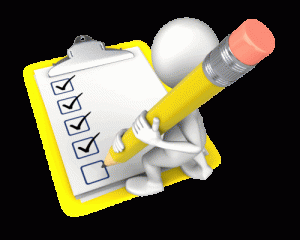How to Write a Strategic Plan
Not to oversimplify how to create a strategic plan, but by placing all the parts of a plan into three areas, you can clearly see how the pieces fit together. The three pieces of the puzzle are:
Where are we now?
Where are we going?
How will we get there?
Each part has certain elements to show you how and where things fit it.
Where are we now?
As you think about where your organization is now, you want to look at your foundational elements (mission and value) to make sure there has not been a change. More than likely, you will not revise these two areas very  often. Then you want to look at your current position or your strategic position. This is where you look at what is happening internally and externally to determine how you need to shift and change You should review your strategic plan regularly through the use of a SWOT. These elements are as follows:
often. Then you want to look at your current position or your strategic position. This is where you look at what is happening internally and externally to determine how you need to shift and change You should review your strategic plan regularly through the use of a SWOT. These elements are as follows:
Mission statement: The mission describes your organization’s purpose in a good strategic Plan — the purpose for which you were founded and why you exist. Some mission statements include the business of the organization. Others explain what products or services they produce or customers they serve. Does your mission statement say what you do? Why does your organization exist?
Values and/or guiding principles: This clarifies what you stand for and believe in. Values guide the organization in its daily business. What are the core values and beliefs of your company? What values and beliefs guide your daily interactions? What are you and your people really committed to?
SWOT: SWOT is an acronym that stand for strengths, weaknesses, opportunities, and threats. These elements are crucial in assessing your strategic position with your organizations starategic plan. You want to build on your company’s strengths; shore up the weaknesses; capitalize on the opportunities; and recognize the threats.
The elements of the question Where are we going? help you answer other questions such as What will my organization look like in the future? Where are we headed? What is the future I want to create for my company? Because the future is hard to predict, you can have fun imagining what it may look like. The following elements help you define the future for your business:
Sustainable competitive advantage: Sustainable competitive advantage explains what your are best at compared to your competitors. Each company strives to create an advantage that continues to be competitive over the time. What can you be best at? What is your uniqueness? What can your organization potentially do better than any other organization?
Vision statement: Your vision is formulating a picture of what your organization’s future makeup will be and where the organization is headed. What will your organization look like in 5 to 10 years from now?
How will we get there?
Knowing how you’ll reach your vision is the meat of your strategic plan, but it’s also the most time consuming. The reason it takes so much time to develop is because there are a number of routes from your current position to your vision in a strategic plan. Picking the right one determines how quickly or slowly you get to your final destination.
The parts of your plan that layout your roadmap are listed below:
Strategic objectives: Strategic objectives are long-term, continuous strategic areas that help you connect your mission to your vision. Holistic objectives encompass four areas: financial, customer, operational, and people. What are the key activities that you need to perform in order to achieve your vision?
What are the key activities that you need to perform in order to achieve your vision?
Strategy: Strategy establishes a way to match your organization’s strengths with market opportunities so that your organization comes to mind when your customer has a need. This section of a strategic plan explains how you travel to your final destination. Does your strategy match your strengths in a way that provides value to your customers? Does it build an organizational reputation and recognizable industry position?
Short-term goals/priorities/initiatives: Short-term goals convert your the strategic objectives into specific performance targets. You can use goals, priorities, initiatives interchangeably. In this book, I use goals to define short-term action. Effective goals clearly state what you want to accomplish, when you want to accomplish it, how you’re going to do it, and who’s going to be responsible. Each goal should be specific and measurable. What are the 1- to 3-year-goals you’re trying to achieve to reach your vision? What are your specific, measurable, and realistic targets of accomplishment?
Action items: Action items are plans that set specific actions that lead to implementing your goals. They include start and end dates and appointing a person responsible Are your action items comprehensive enough to achieve your goals?
 Scorecard: A scorecard measures and manages your strategic plan. What are the key performance indicators you need to track to monitor whether you’re achieving your mission? Pick 5 to 10 goal related measures you can use to track the progress of your plan and plug them into your scorecard.
Scorecard: A scorecard measures and manages your strategic plan. What are the key performance indicators you need to track to monitor whether you’re achieving your mission? Pick 5 to 10 goal related measures you can use to track the progress of your plan and plug them into your scorecard.
Execution: In executing the plan, identify issues that surround who manages and monitors the plan and how the plan is communicated and supported. How committed are you to implementing the plan to move your organization forward? Will you commit money, resources, and time to support the strategic plan.
https://www2.gotomeeting.com/register/400866258
Developing a Strategic Business Plan with Melanie Swift
How do you determine if your ready to apply for a 501c3, are you jeopardizing your organization by not having one? What are the advantages and protections of having a 501c3? How can a 501c3 open new fundraising doors and allow more freedom in your organization? Join us for this free webinar, and find a fact filled discussion on one of the most important issues facing our industry today, 501c3!. All of this information and much more is yours in this FREE webinar
We invite you to spend a valuable hour with CharityNet USA and our Director of Nonprofit Services Melanie Swift and discover another way we can help your nonprofit organization cannot only overcome, but grow during the current economic conditions.
As the past shows: the economy will recover, resources will catch up with us and finances will level out. Don’t wait for recovery to happen, get started growing your nonprofit now. When America recovers, your nonprofit will not only be in the game, but you will be an MVP!
Contact Marketing Coordinator Thomas R. Reich for more info at tom@Bizcentralusa.com or call him at (407) 857-9002 ex 510
Webinar Registration
Wednesday,Sept 12, 2012
2:00 pm – 3:00 pm online from CharityNetUSA
Key Note Speaker: Melanie Swift
https://www2.gotomeeting.com/register/400866258



